Sigma 50-150 mm f/2.8 APO EX DC OS HSM
3. Build quality and image stabilization
Big dimensions and weight of the Sigma 50-150 mm OS tempted us to compare it to other stabilized 70-200 mm f/2.8 lenses and you can see the results in the next chart. As you can notice the Sigma 50-150 mm OS is physically the lightest here but the differences aren’t huge, stemming mainly from the smallest number of elements and groups. What’s the most interesting thing the dimensions of the tested Sigma are exactly like those of its full frame equivalent of the same brand name. If you compare those two instruments more closely you can find out they are…identical. I bet this decision was completely understandable from the point of view of bookkeepers – it is cheaper to produce one casing than two. From the point of view of customers, though, such a choice is rather controversial to say the least of it. A smaller sensor gives you a possibility to construct a smaller lens with the same parameters and often better optical properties. Here the producer decided to reject such an option.
You can assess how big the Sigma 50–150 mm OS is looking at the photo in which it is positioned next to the Canon EF 70-300 mm f/4.0-5.6 IS USM and the Sigma 1.4/30 EX.
Please Support UsIf you enjoy our reviews and articles, and you want us to continue our work please, support our website by donating through PayPal. The funds are going to be used for paying our editorial team, renting servers, and equipping our testing studio; only that way we will be able to continue providing you interesting content for free. |
- - - - - - - - - - - - - - - - - - - - - - - - - - - - - - - - - - - - - - - - - - - - - - - -
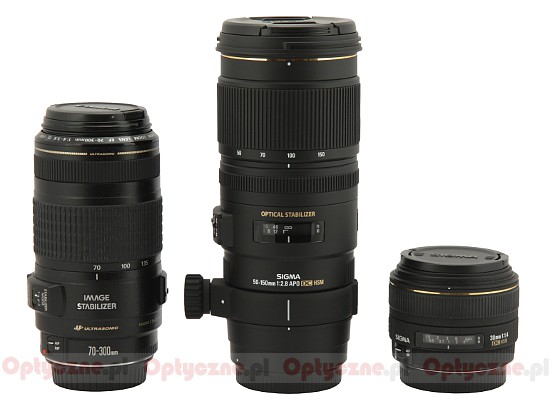 |
The tested lens starts with a metal mount surrounding contacts and a rear element, about 37 mm in diameter. The rear element is immobile, and it hides inside the barrel about 2 cm deep. The tube around it is black with a very nice matt finish.
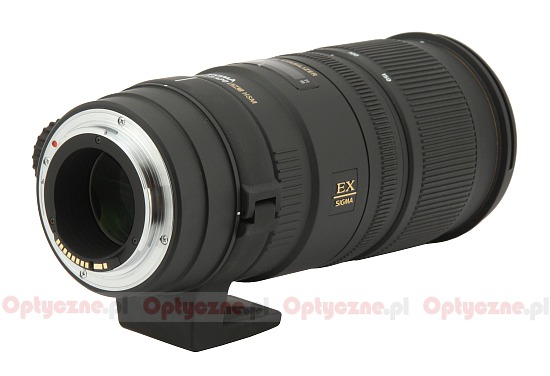 |
On the proper casing first you see a smooth part which soon turns into a solid, removable tripod adapter (added by the producer in the box). Right behind the adapter there is an inscription with the name and the parameters of the lens. The next element consists of a clear distance scale, expressed in meters and feet, put behind a window. On its right you see the “EX” mark, meaning you deal with one of Sigma’s top-of-the-range lenses. On the left there is a series of switches: the first one allows you to choose the focusing mechanism mode (AF/MF) and the second one controls the stabilization (OS OFF, mode 1, mode 2).
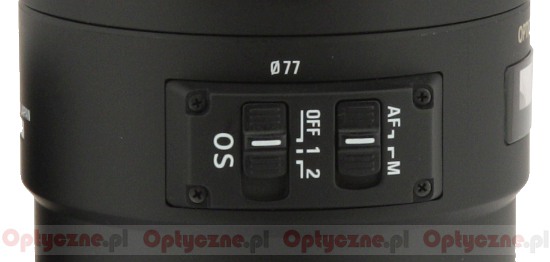 |
Further on you can find a manual focus ring, 22 mm wide, half of it covered by ribs. Running through the whole scale takes a turn through 130 degrees. The next part is a huge zoom ring. It is as wide as 46 mm; most of it is taken by rubber ribbing under which you can find focal length markings at 50,70,100 and 150 mm. The ring moves smoothly and is well damped.
Behind the zoom ring there is an immobile part of the casing with a golden stripe, characteristic for the EX series, which turns smoothly into a hood mount. The mount surrounds a non-rotating filter thread, 77 mm in diameter. The front element is 69 mm in diameter, immobile and positioned just slightly inside the casing.
The optical construction of the lens consists of 21 elements in 15 groups. As many as six elements have been made of low dispersion SLD glass – compared to the predecessor the increase is significant. The overall number of elements is by three pieces higher and the number of SLD elements – by two. Inside the lens you can also find a circular aperture with nine blades which can be closed down to f/22.
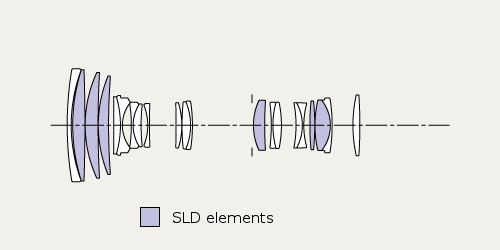 |
As it is often the case with the EX Sigma series, you get a quite rich accessory kit - both caps, a hood, a solid tripod adapter and a hard case with a strap.
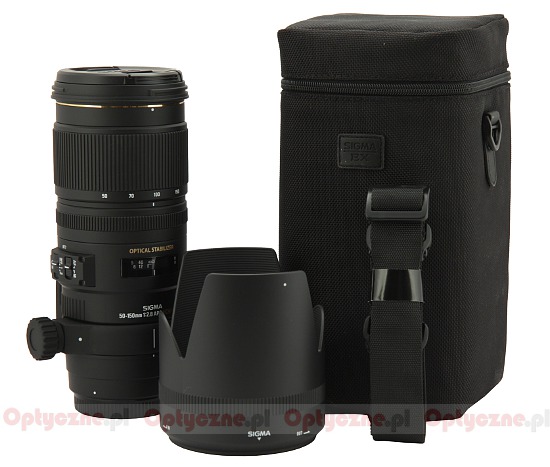 |
Optical stabilization
Currently almost every lens producer boasts of a stabilization mechanism as efficient as 4 EV. Sigma follows suit – they claim that the 50–150 mm f/2.8 APO EX DC OS HSM model features exactly such a highly efficient stabilization system. Of course we had to check that claim. In order to do that we took several dozen photos for every exposure time ranging from 1/250 to 1/5 of a second with the stabilization switched on and off. Then we determined the number of blurred photo for every exposure and presented the results as a function graph of the exposure time, expressed in EV (where 0 EV is an equivalent of 1/200 of a second).
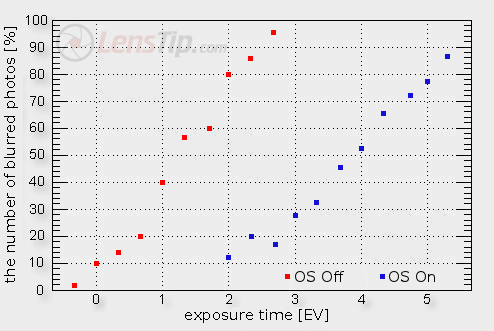
As you see on the graph above the maximum distance between both curves amounts to a bit more than 3 EV and so we assess the efficiency of the Sigma’s 50-150 mm OS stabilization system. The result is quite typical for this class of equipment and we consider it good. It’s worth noticing, though, that it remains worse than the sensational results reached by the newest 70-200 mm class lenses, launched by Canon and Nikon.






